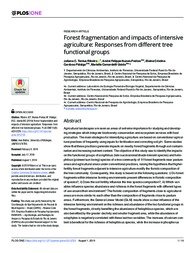Forest fragmentation and impacts of intensive agriculture: responses from different tree functional groups.
Forest fragmentation and impacts of intensive agriculture: responses from different tree functional groups.
Author(s): RIBEIRO, J. C. T.; NUNES-FREITAS, A. F.; FIDALGO, E. C. C.; UZEDA, M. C.
Summary: Agricultural landscapes are seen as areas of extreme importance for studying and developing strategies which integrate biodiversity conservation and ecosystem services with food production. The main strategies for intensifying agriculture are based on conventional agricultural practices of frequently using inputs for fertilization and correcting soil pH. Some studies show that these practices generate impacts on nearby forest fragments through soil contamination and increasing nutrient content. The objective of this study was to identify the impacts on the functional groups of sciophilous (late successional/shade-tolerant species) and heliophilous (pioneer/sun-loving) species of a tree community of 14 forest fragments near pasture areas and agricultural areas under conventional practices, raising the hypothesis that higher-fertility forest fragments adjacent to intensive agriculture modify the floristic composition of the tree community. Consequently, this study is based on the following questions: i) Do forest fragments within intensive farming environments present differences in floristic composition of species?; ii) Does the soil fertility influence the tree species composition?; iii) Which variables influence species abundance and richness in the forest fragments with different types of use around their environment? The floristic composition of fragments close to agricultural areas are more similar to each other than the composition of fragments close to pasture areas. Furthermore, the General Linear Model (GLM) results show a clear influence of the intensive farming environment on the richness and abundance of the two functional groups in the forest fragments, directly benefiting the abundance of heliophilous species, which are also benefited by the greater declivity and smaller fragment area, while the abundance of sciophytes is negatively correlated with these last two variables. The increase of calcium content is beneficial for the richness of heliophilous species, while the increase in phosphorus content influences a reduction in the richness of sciophyte species, which also strongly respond to the isolation between fragments. The results indicate a dominance trend of pioneer species in fragments with nutritionally enriched soils, providing evidence that the intense adoption of inputs in cultivated areas causes concrete impacts on the diversity of the tree community.
Publication year: 2019
Types of publication: Journal article
Unit: Embrapa Soils
Keywords: Agricultura, Agriculture, Fertilidade do Solo, Floresta, Forests, Landscapes, Soil fertility
Observation
Some of Embrapa's publications are published as ePub files. To read them, use or download one of the following free software options to your computer or mobile device. Android: Google Play Books; IOS: iBooks; Windows and Linux: Calibre.
Access other publications
Access the Agricultural Research Database (BDPA) to consult Embrapa's full library collection and records.
Visit Embrapa Bookstore to purchase books and other publications sold by Embrapa.

